Cont from page one
2,800 BC - The 'Composite Bow' first appears. The Egyptians further developed this type of bow. Made from wood, tipped with animal horn and held together with animal sinew and glue. The unstrung bow resembled a 'C' shape and required two people to string it. The bowstrings were made from 'catgut' obtained and made from sheep's intestines.
The arrows were extremely light and when used with the composite bow, could be shot 366 metres ( 400 yards ) and the armour of the day was no protection against such weapons.
The Egyptians used archers on the back of light chariots. These were organised into highly trained units able to quickly out-flank an enemy army with devastating effect.
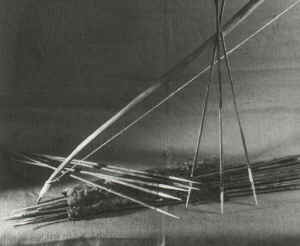 | Egyptian bow and arrows from
approx. 2,300 BC-1400 BC.
Bow length = 62"-68" (160-173cm)
Arrows made from reeds with hard foreshafts 8"(20cm) long bound into the shaft with very fine linen thread then tipped with flint heads. The fletchings are 3"(7.5cm) long feathers glued to the shafts with shellac.
Arrow length = 34"-37"(86-94cm).
Arrow weight = 0.4-0.5oz(10-14gm). |
2,600 BC - Pyramids of Caral, situated about 125 km north of Lima in Peru, South America were built to form a large city complex. The large stepped pyramids even exceed the size of the pyramids in Egypt for sheer volume of material used. The neighbouring river was used to irrigate crops of cotton, which was then woven into fishing nets to trade with the coastal fishing villages in exchange for fish. This peaceful trading city was thought to exist for the next 600 years.
(Archaeological digging is still revealing how these ancient city dwellers lived.)
2,500 BC - Akkadians conquered Sumeria with infantry archers.
1,500 - 1027 BC - First mention of Crossbows in China.
1479 BC - 1426 BC - The King of Egypt, Thutmose III, was reported to be a highly skilled warrior in archery and horsemanship, often giving public displays of his skill. He expanded the Egyptian empire to cover Syria and Sudan. Many temples and monuments were built to commemorate his triumphs.
1288 BC - Battle for Kadesh between the Pharaoh Ramses II and the Hittite King, Mutallu. The highly mobile Egyptian archers on the back of chariots were able to defeat the Hittite army.
1260 BC - 1240 BC - Philoctetes had been bequeathed the bow and arrows of the Greek hero Heracles in return for lighting his funeral pyre, thus he became a notable archer. On the way to the siege of Troy he was incapacitated by a snakebite and was left behind. After a seer revealed that Troy could be taken only with the aid of Heracles' bow and arrows, the Greek warriors Odysseus and Diomedes went to Philoctetes and persuaded him to accompany them to Troy. There he was healed of his wound and killed Paris, son of the King of Troy, by which action he paved the way for the city's fall through using the 'Trojan Horse'.
1209 BC - Merneptah, son of Ramses II (Pharaoh of Egypt) used his archers to defeat an invading army of Libyans, who lost nearly 9,400 men in the battle.
1,200 - 700 BC - Assyrian archers shot from chariots while the charioteer held a shield for protection.
In China, the nobility of the time attended special schools where they were taught archery, music, rituals, charioteering, mathematics and writing
490 BC - 'Battle of Marathon', Athenian infantry of 11,000 men with long spears, swords and armour defeated Persian archers after a rapid charge to avoid the shower of arrows. The Persian army of 15,000 men were flanked by the infantry and lost 6,400 men killed in retreat back to their ships. The Athenians only lost 192 men. According to legend, an Athenian messenger was sent from Marathon to Athens, a distance of about 40 km(25 miles), and there he announced the Persian defeat before dying of exhaustion.
360 BC - Macedonian - archers on horseback used to support other cavalry troops.
327 BC-326 BC - Indian prince, Porus, who ruled the region between the Hydaspes (Jhelum) and Acesines (Chenab) rivers at the time of Alexander the Great's invasion of the Punjab. Porus resisted Alexander, but with his elephants and slow-moving infantry bunched, he was out-flanked by Alexander's mobile cavalry and mounted archers in the battle of the Hydaspes. Impressed by his techniques and spirit, Alexander allowed him to retain his kingdom.
260 BC - Hannibal used cavalry archers.
250 BC - Parthians (Iran/Afghanistan) were excellent horsemen and archers. In battle they would often shoot their arrows back towards the enemy while pretending to flee.
This could be where the phrase "a Parthian Shot" became today's phrase "a Parting Shot".
221 BC - Qin Shihuang, First Emperor of China. Discovery of his 'Terracotta Army' in 1974. The burial pits contain approx. 6,000 life size figures.
| 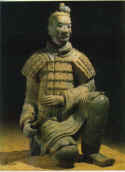
| 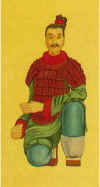
| 
| 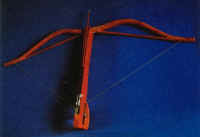
|
| Terracotta
CrossBowman | Painted
Reconstruction | Bronze
CrossBow
Bolts | Reconstructed
CrossBow |
| He is wearing plated armour over a battle robe. | Colour version based on original paint samples. | Triangular points on circular stems.
200mm long. | Body is 720mm long. Has bronze trigger mechanism. Estimated range is 800 metres. |
53 BC - Parthians tried to invade Rome with some success, but bows and arrows were not much good against garrison walls.
37 BC - Roman troops invaded Parthia, but lost many 1,000's to hit and run tactics.
200-300 AD - The late Han/Jin Period.
| 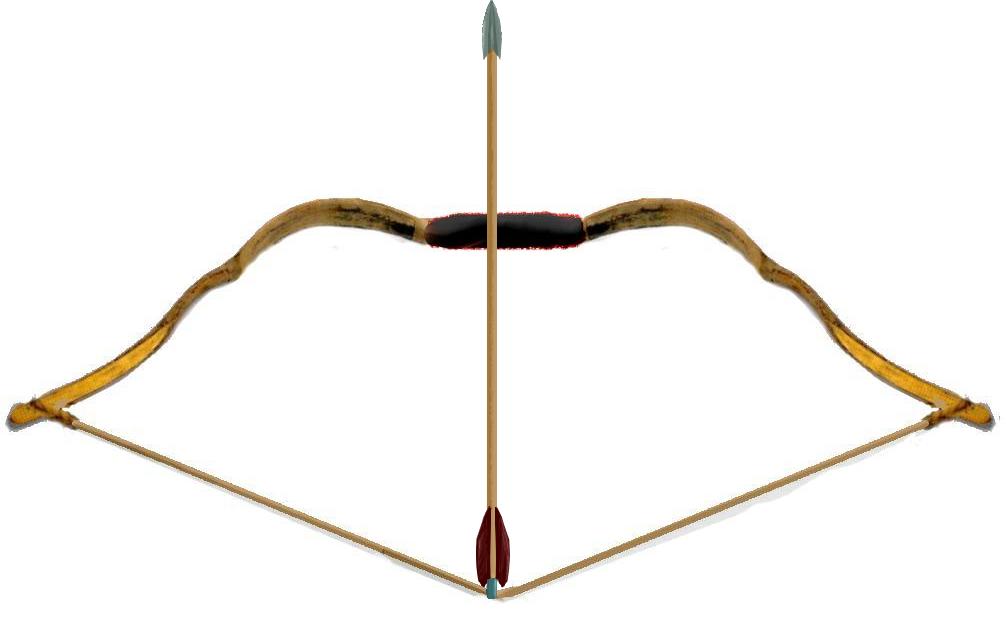
| Bow: Length: 130 cm. Width: 0.6 cm - 3.2 cm. Thickness: 0.6 cm - 4.6 cm. Arrow: Length: 73.5 cm. Graphical reconstruction of the Niya Bow by Stephen Selby. (from original on display in the Revolutionary Museum in Beijing, China.)
An example of a Magyar (Hungarian) composite recurve bow. |
288 AD -  | Sebastian commanded a company of the Preatorian Guard for the Roman Emperor, Diocletian. After his secret belief in Christianity was revealed, he refused to renounce his faith. The emperor ordered that he be bound to a stake and shot to death with arrows. He was left for dead after several arrows, but a friend discovered that he was still alive and nursed him back to health. Later he proclaimed his Faith from the steps of the Emperor's Palace.
The guards were ordered to beat him to death with clubs and his body was thrown in the sewer. His body was recovered by friends and buried in the catacombs.
|
376 AD - the Pope, St. Damascus, built a Basilica over Sebastian's tomb which is now one of the seven principal churches in Rome.
Now St. Sebastian is the Patron Saint of Archers.
434 AD - Attila the Hun - Reined as King from 434-453AD. The Huns used composite recurve bows from horseback with deadly effect on opposing armies.
The Hun kingdom was located in modern-day Hungary. Attila embarked immediately upon a series of wars extending Hun rule from the Rhine across the north of the Black Sea as far as the Caspian Sea. Some historical accounts number his army between 300,000 to 700,000 troops, which for those times, is a huge force of arms. The defeat of his army by the allied Roman and Visigoth armies at Chalons in 451 AD thwarted his first campaign into Western Europe. The following year, he invaded Northern Italy, nearly securing Ravenna, but halted at the request of Pope Leo I and returned home to his capital near present day Budapest. He died in 453 AD, supposedly choking to death of a nosebleed while in a drunken stupor after marrying another wife.
552 AD - 'Battle of Taginae', the Byzantine emperor, Justinian I sent his commander, Narses, with an army of 20,000 men into Italy, where, at the Apennine village of Taginae near the Flaminian Way, he defeated the Goths. The Goth commander, Totila, had ordered his army to use only spears, was fatally wounded. The victory, credited to imperial archers, allowed Narses to march through Italy and eventually liberate Rome.
500 - 900 AD - Byzantines used mounted archers and then a cavalry charge against the Saracen's, Vandal's, Goth's and Frank's. The Avars used mounted archers using stirrups to stand while shooting, thus increasing their accuracy.
900 AD - Byzantines changed to using archers on foot.
1066 AD - The Battle of Hastings - King Harold of England was waiting for the invasion of William of Normandy.
It is believed that King Harold was killed by an arrow through the eye which resulted in victory for William.
 | Part of the Bayeux Tapestry showing King Harold struck by the arrow. |
1099 AD - Crusades. English knights and crossbowmen attack the Mohammadean army that mainly consisted of archers on horses armed with composite bows.
1100 AD - 2nd. August. William II, King of England, is killed by an arrow shot by Sir Walter Tyrel while hunting in the new forest. Sir Walter flees the country. Also in the hunting party is William's brother who succeeds him as Henry I and immediately takes possession of the treasury. There is suspicion that this may not have been an accidental shooting to gain the throne of England.
1100-1135 AD - Henry I proclaimed that an archer would be absolved of murder, if he killed a man during archery practise.
( An ironic touch.)
1147-1149 AD - Crusades ?.
1189 - 1192 AD - Crusades. King Richard killed with a crossbow bolt shot by a defender using one of the attacking army's crossbow bolts. The bolt didn't kill Richard outright, but the wound became infected after the arrow head was cut out
will cont on page 3
 Free Forum Hosting
Free Forum Hosting